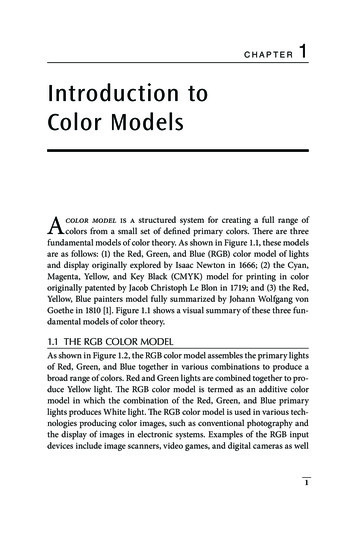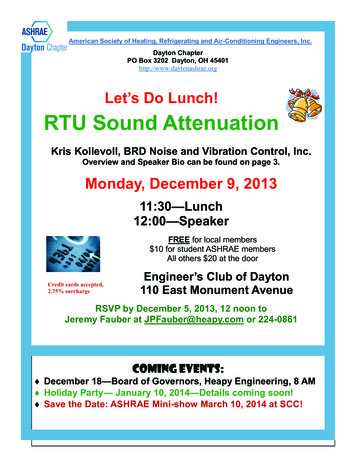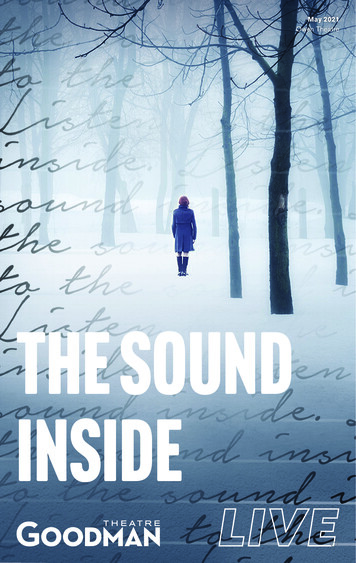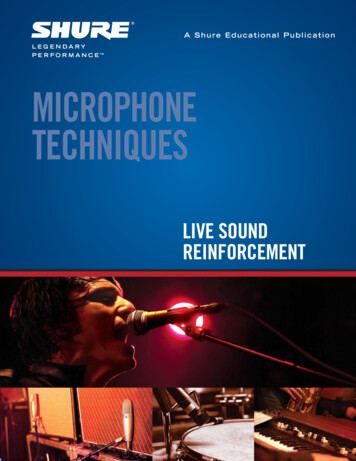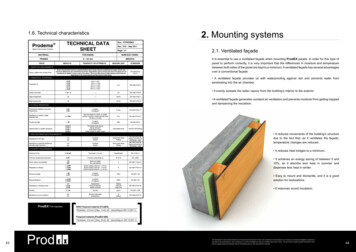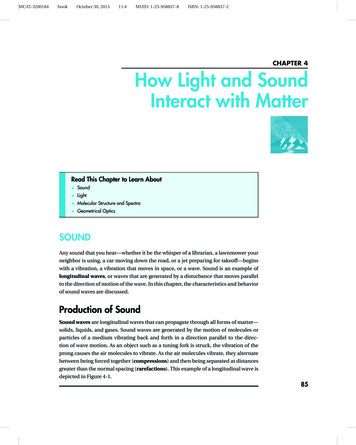
Transcription
A Rout l edge/ Focal FREEBOOKSound Product ion Today1
Introduction01:: Good Sound from Mic It!02:: Sound Elements from Camera AudioSimplified03:: Demystifying Recording Levels from AudioProduction Tips2
Learn more about Audio Product ions wit ht he f ul l books excerpt ed in t his FreeBook:Related titles:Visit Routledge.com/ audio to browse our fullrange of Audio titles3
IntroductionThis FreeBook is a one-stop shop for great sound engineering tips from some of today?sleading audio experts. Whether you are recording music or shooting live audio, you arebound to find some useful information within these pages.CHAPTER ONE of this FreeBook comes from Ian Corbett?s book Mic It! The sample is fromchapter three, ?Good sound?where Corbett teaches reader what ?good sound?is and how toachieve it in a home recording studio.About Mic It!: Capture great sound in the first place, and spend less time"fixing it in the mix" with Ian Corbett?s Mic It! Microphones, MicrophoneTechniques, and Their Impact on the Final Mix. With his expert guidance, you?llquickly understand essential audio concepts as they relate to microphones andmic techniques.Dr. Ian Corbett is the coordinator of the Audio Engineering Program, andProfessor of Music Technology and Audio Engineering at Kansas City KansasCommunity College. He also owns and operates "off-beat-open-hats ?recording and sound reinforcement" which specializes in servicing the needs ofjazz and classical ensembles in the Kansas City area.CHAPTER TWO features a chapter on Sound Elements from Camera Audio Simplified. If youare making a film using a video camera and need a little help with the audio, this section isfor you.About Camera Audio Simplified: You?ve spent a lot of time learning how to usethe features of your video camera to take amazing pictures, but chances arethe audio always gives you trouble! To achieve great sound to go along withgreat video, you need to go beyond "automatic" mode and take control ? knowas much about microphones as you do about lenses with the help of CameraAudio Simplified.Author Dean Miles gives you the skills you need to capture quality locationaudio with your camera mic, wireless system, lavaliers, and handheldmicrophones. You?ll get step-by-step guidance to help elevate your sound fromamateur to professional ? and build your career and video production business.4
CHAPTER THREE, Demystifying Recording Levels from Audio Production Tips, breaks downthe science of sound with easy-to understand examples.Audio Production Tips: Getting the Sound Right at the Source providespractical and accessible information detailing the production processes forrecording today?s bands. By demonstrating how to "get the sound right at thesource," author Peter Dowsett lays the appropriate framework to discuss thetechnical requirements of optimizing the sound of a source.Peter Dowsett is a British audio engineer known for his experience withmany facets of the music industry including studio engineering, mixing,mastering and live sound. In the studio he has worked at Metropolis studioswith clients including Pharrell Williams, Snoop Dogg, Rick Ross, DowntonAbbey, Nick Jonas, and Dappy. His work has been synced on ABC, Channel 5and featured on cover CDs for Metal Hammer magazine.Happy reading and recording!5
1Good Sound6
Chapter 1: Good SoundRECOGNIZING GOOD SOUND:Before even thinking of plugging in and setting up a microphone, it is important tounderstand what the desirable characteristics (and undesirable characteristics) insound are. That?s why there are some chapters in this book like this one ? that don?tdirectly discuss microphones, but discuss things you need to know in order to usemicrophones to capture the best, most suitable sound possible.The following is excerptedfrom Mic It!: Microphones,Microphone Techniques, andTheir Impact by Ian Corbett. 2015 Taylor & FrancisGroup. All rights reserved.Learn more:There?s no simple answer to the question ?what is good sound?The best answer mightbe along the lines of ?whatever is stylistically and artistically appropriate.?Good soundis subjective. One person?s ideal guitar sound may be another person?s worst nightmare? however that is often related to whether a sound is appropriate to the context it?s in,rather than the sound being simply ?good?or ?bad.?But bad sound certainly does exist!Poor quality sound sources, poor quality equipment, bad recording techniques, and poormixing skills can all result in inappropriate, questionable, or just plain ?wrong?sound!How do you learn to record and mix well? There are basic concepts and skills thatshould be mastered before developing your own style. Musicians develop their skillsets and individual musical style by listening to other musicians, emulating them, andeventually synthesizing many influences into their own unique characteristics. As asound engineer or producer, you should similarly find good quality recordings, listen tothem, analyze them, and try to emulate them ? building up your skills and techniquesbefore eventually developing your own style.Listening to, and becoming intimately familiar with, a wide variety of musical andproduction styles will make you more marketable in the industry ? if you only listen tohip-hop, good luck when an acoustic folk band shows up for a show or session you?reworking! Hopefully, like many audio professionals, you can combine your love of greatsounding recordings with artists you enjoy musically. Don?t just listen to music becauseyou like the style or the artists ? when starting to listen critically, it?s often easier toconcentrate on the sound, and not be distracted by the music, when you?re listening toartists and styles you?re not a fan of. It?s very easy for your love of an artist or band topersuade you that the recording is better than it actually is!What do you need to be aware of, how should you be listening, and what should you belistening for, in order to identify the desirable characteristics of a recording?SOUND REPRODUCTION FORMATSMONOA mono, or monophonic playback system has only one loudspeaker, as in Figure 2.1.7
Figure 2.1 A mono reproduction system with a single loudspeaker. Sound from theloudspeaker arrives at both ears at the same time (if the loudspeaker is centered). Themono format only allows sounds to be positioned along the loudspeaker?s limitedfront/back axis. The result is a spatially congested image, making mix clarity achallenge.Mono playback systems include some TVs, bedside alarm clock radios, ceiling typeloudspeaker systems in retail outlets (which have many distributed loudspeakers, thatare all sent the same signal), and speakers on many tablets and mobile phones. Monosystems are one-dimensional. They can offer a sense of front/back depth through theuse of creative recording and mixing techniques, but there is no sense of wide space,and all the sounds come from the same location. It is potentially difficult for a listenerto clearly hear everything that might be going on in a mono mix, which makesachieving a good mono mix very challenging.A small nasty sounding mono Auratone type loudspeaker is a common feature in manyprofessional recording studios ? enabling engineers to anticipate the effects of poorquality, mono sound systems, and make sure their product translates acceptably tothem.STEREOStereo, or stereophonic systems feature two playback channels ? left and right.Different signals are sent to each, as shown in Figure 2.2. In a stereo loudspeaker8
receive the same wavefront at the same time, followed by identical slightly delayedinter-aural crosstalk. The listener perceives this sound as coming from a centrallocation, directly between the loudspeakers ? where there is no physical loudspeaker.The illusion of a sound located where there is no loudspeaker is called a phantomimage.The stereo format is a two-dimensional format when creative recording and mixingtechniques are used: - There is clearly a sense of left/right directionality, because it ispossible to position sounds anywhere between the loudspeakers, and to create theillusion that sound is coming from just beyond the physical loudspeakers.- It is also possible to create the illusion of front/back depth.- To a lesser degree, it is possible to create the limited illusion of a third dimension ?height.CHECK YOUR MONO COMPATIBILITY!Checking your stereo project sounds good in mono ? its mono compatibility ? is veryimportant. You never know what type of system your project will end up being heard on.Cheap TVs, cell phone speakers, elevator music systems, bedside clock radios, and mostceiling speaker systems in shops and stores are all mono systems. The last thing youwant is for your mix to sound bad, or for sounds or certain frequency ranges to partially,or in extreme cases, completely disappear when a stereo mix is summed to mono.Most mixing consoles and DAWs have a mono button in their monitor section. This sumsthe stereo mix to mono to check this compatibility. The feature is there for a reason ?use it! Significant tone, timbre, or frequency balance (equalization) changes, when a mixis folded down to mono, usually indicate a mono compatibility problem that needsfixing.SURROUND SOUNDMultichannel surround sound formats, such as 5.1 and 7.1, utilize additionalloudspeakers which surround the listener. They offer the advantage of being able toenvelop the listener with sound coming from behind and to the side of the listeningposition. Additionally, a dedicated center channel loudspeaker can take the place ofcenter phantom images, and provide alternate sonic imaging qualities. New formatswith height channels are being explored and developed ? these truly result in athree-dimensional listening experience. Surround sound formats are beyond the scopeof this book, and stereo production should be mastered before attempting any type ofsurround sound production.9
MONITORING OPTIONS ? LOUDSPEAKERS, HEADPHONES, AND EARBUDSStereo is the most common consumer listening format, and a pair of studioloudspeakers, called monitors, are the preferred listening system when recording,mixing, and mastering in stereo. Boom boxes, hi-fi systems, stereo televisions, carstereos, and the plethora of portable media players (PMPs) such as MP3 players, iPods,and multimedia mobile phones all offer two-channel ?stereo?playback. But are all ofthese devices actually stereo?Figure 2.2 showed that a stereo system creates inter-aural crosstalk that our hearingsystem uses to determine the directionality of sound. Figure 2.3 shows a pair ofheadphones (or earbuds) on a listener. There is no inter-aural crosstalk in this system ?the sound from the left driver goes only into the left ear, and the sound from the rightFigure 2.3 A binaural headphone or earbud system lacks the inter-aural crosstalknecessary to make it a true stereo system.driver goes only into the right ear. The only directional information presented to andprocessed by our brain is the amplitude difference of the sound between each ear. Forthis reason, headphones and earbuds should not really be called stereo, despite thelabeling to the contrary on the retail packaging! They are in fact binaural ? featuringtwo channels, minus the inter-aural crosstalk necessary to make them a true stereosystem.There are several reasons that mixing using high quality, professional loudspeakers ispreferable to mixing using headphones:- Mixes created on loudspeakers translate very well to headphones. Mixes createdon headphones do not translate as well to loudspeaker systems.- ?But most of the listeners will be using earbuds anyway.?It is perfectly OK, and10
Figure 2.2 A stereo reproduction system uses two channels, each sending its ownunique signal.system, sound from the left loudspeaker travels to the left ear, and the right ear ?where it arrives slightly later, changed in timbre due to the extra distance, andfiltering/equalization effects of wrapping around the face and head. These delay andEQ effects are known as HRTFs, or head related transfer functions. Similarly, sound fromthe right loudspeaker travels to the right ear, and also the left ear ? again, slightlydelayed and changed in timbre. The sound transfer to each ?opposite?ear is known asinter-aural crosstalk, and is an essential and desirable component of a stereo playbackor monitoring system.The inter-aural crosstalk between the speakers and each opposite ear (the dashedlines) is an essential component of the format. The path from the left loudspeaker tothe right ear is slightly longer than to the left ear, therefore the left loudspeaker?ssound arrives slightly later at the right ear, and its tonality is changed as it wrapsaround the face and head.The reason a sound coming from just the left loudspeaker sounds like it?s coming fromjust the left loudspeaker (even though the sound travels to both of our ears) is becauseour brain uses the HRTF sub-millisecond-level time-delay and the EQ differences of thewavefront?s arrival at each ear to determine directionality. We perceive the sound ascoming from the direction of the ear at which the wavefront first arrived. This is knownas the Law of First Wavefront, or Haas Effect, or Precedence Effect.If both loudspeakers reproduce an identical sound wave simultaneously, both ears11
good, to check a mix on headphones or earbuds. But to create a stereo mix that willbest translate to the greatest variety of playback systems, the mix should be craftedon a stereo loudspeaker system. A mix that doesn?t translate well to manyreproduction systems, or future systems, will have a more limited audience, and amore limited lifespan.- Headphones do not present the same stereo image or front/back depth thatstereo loudspeaker systems are capable of. While a headphone image may becorrectly described as more precise and surgical, it is also smaller and morecompact. If you are mixing for headphones exclusively, then knowledge of some ofthe miking techniqu
recording and sound reinforcement" which specializes in servicing the needs of jazz and classical ensembles in the Kansas City area. CHAPTER TWO features a chapter on Sound Elements from Camera Audio Simplified. If you are making a film using a video camera and need a little help with the audio, this section is for you. About Camera Audio Simplified: You?ve spent a lot of time learning how

